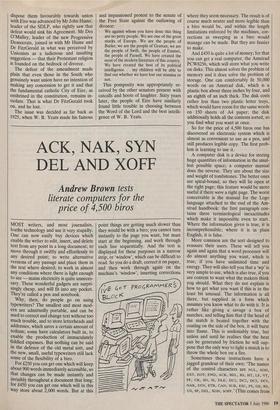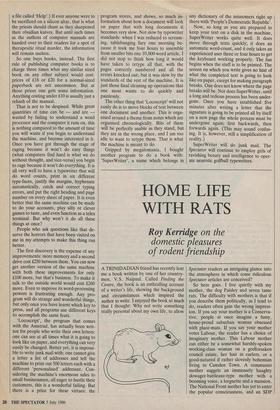ACK, NAK, SYN DEL AND XOFF
Andrew Brown tests literate computers for the price of 4,500 biros
MOST writers, and most journalists, loathe technology and use it very stupidly. One can now easily buy devices which enable the writer to edit, insert, and delete text from any point in a long document; to move through it swiftly and effortlessly to any desired point; to write alternative versions of any passage and place them in the text where desired; to work in almost any conditions where there is light enough to see — mains electricity is quite unneces- sary. These wonderful gadgets are surpri- singly cheap, and will fit into any pocket. They're called a pen and notebook.
Why, then, do people go on using typewriters? The smallest and most mod- ern are admittedly portable, and can be used to correct and change text without too much trouble, and to store letterheads and addresses, which saves a certain amount of tedium; some have calculators built in, to enable the production of immaculately -fiddled expenses. But nothing can be said in the defence of the old metal sort, and the new, small, useful typewriters still lack some of the flexibility of a biro.
For £250 you can get one which will keep about 900 words immediately accessible, so that changes can be made instantly and invisibly throughout a document that long; for £450 you can get one which will in this way store about 2,000 words. But at this point things are getting much slower than they would be with a biro; you cannot turn instantly to the page you want, but must start at the beginning, and work through each line sequentially. And the text is displayed for these purposes in a narrow strip, or 'window', which can be difficult to read. So you do a draft, correct it on paper, and then work through again on the machine's 'window', inserting corrections where they seem necessary. The result is of course much neater and more legible than a biro would be, and within the length limitations enforced by the machines, cor- rections as sweeping as a biro would manage can be made. But they are fussier to make.
And £450 is quite a lot of money; for that you can get a real computer, the Amstrad PCW8256, which will store what you write on disks. This almost solves the problem of memory and it does solve the problem of storage. One can comfortably fit 50,000 words on an Amstrad disk, which is a plastic box about three inches by four, and an eighth of an inch thick. The disk costs rather less than two plastic letter trays, which would have room for the same words on 150 sheets of A4 paper; the disk additionally holds all the contents sorted, so you find what you want at once.
So for the price of 4,500 biros one has discovered an electronic system which is almost as convenient to use as a pen, and still produces legible copy. The first prob- lem is learning to use it.
A computer disk is a device for storing huge quantities of information in the smal- lest possible space; a computer manual does the reverse. They are about the size and weight of tombstones. The better ones are spiral-bound, so they will lie open at the right page; this feature would be more useful if there were a right page. The worst conceivable is the manual for the Logo language attached to the end of the Am- strad handbook: the first paragraph con- tains three terminological inexactitudes which make it impossible even to start. Where the information given is true, it is incomprehensible; where it is in plain English, it is false.
More common are the sort designed to reassure their users. These will tell you again and again that a word processor will do almost anything you want, which is true, if you have unlimited time and energy. They will also tell you that a `wp' is very simple to use, which is also true, if you are content to want what the makers think you should. What they do not explain is how to get what you want if this is in the least bit unusual. The information is all there, but supplied in a form which assumes you know what to do with it. It is rather like giving a savage a box of matches, and telling him that if the head of the match is heated together with the coating on the side of the box, it will burst into flame. This is undeniably true, but unless and until he realises that the heat can be generated by friction he will sup- pose that the only way to light a match is to throw the whole box on a fire.
Sometimes these instructions have a jagged grandeur of their own: 'The names of the control characters are NUL, SOH, EXT, EOT, ENQ, ACK, BEL, BS, HT, LF, VT, FF, CR, SO, SI, DLE, DC1, DC2, DC3, DC4, NAK, SYN, ETB, CAN, SUB, ESC, FS, GS, RS, US, SP, DEL, XON, SOFF.' (This comes from a file called 'Help%) If ever anyone were to be sacrificed on a silicon altar, that is what the priests should chant as they sharpened their obsidian knives. But until such times as the authors of computer manuals are handed over to their readers for a spot of therapeutic ritual murder, the information will remain useless.
So one buys books, instead. The first rule of publishing computer books is to charge three times what any similar sized book on any other subject would cost: prices of £18 or £20 for a normal-sized paperback are not uncommon. But at those prices one gets some information. Anything costing under £10 is usually just a rehash of the manual.
That is not to be despised. While great quantities of time can be — and are wasted by failing to understand a word processor and the computer it runs on, this is nothing compared to the amount of time you will waste if you begin to understand the machine, and become interested in it.
Once you have got through the stage of raging because it won't do easy things (what computers find hard is what we do without thought, and vice-versa) you begin to rage because it won't do everything. It is all very well to have a typewriter that will do word counts, print in six different type-faces, justify the margins, hyphenate automatically, catch and correct typing errors, and put the right heading and page number on every sheet of paper. It is even better that the same machine can be made to do your accounts, play silly or clever games to taste, and even function as a telex terminal. But why won't it do all these things at once?
People who ask questions like that de- serve the horrors that have been visited on me in my attempts to make this thing run better.
The first discovery is the expense of any improvements: more memory and a second drive cost £250 between them. You can now get another version of the same machine with both these improvements for only £100 more, but that's business. To make it talk to the outside world would cost £260 more. Even to improve its word-processing powers is frustrating enough. Any pro- gram will do strange and wonderful things, but only once you have learnt which key to press, and all programs use different keys to accomplish the same feats.
`Locoscript' , the program that comes with the Amstrad, has actually been writ- ten for people who write their own letters: one can see at all times what it is going to look like on paper, and everything can very easily be changed. Better yet, it is impossi- ble to write junk mail with: one cannot give a letter a list of addresses and tell the machine to print out 500 letters each with a different 'personalised' addressee. Con- sidering the machine's enormous sales to small businessmen, all eager to hustle their customers, this is a wonderful failing. But there is a price for these virtues: the program stores, and shows, so much in- formation about how a document will look on paper that with long documents it becomes very slow. Not slow by typewriter standards: when I was reduced to scream- ing, tablebanging fury one morning be- cause it took me four hours to assemble from smaller bits one 10,000-word article, I did not stop to think how long it would have taken to retype all that, with the pages correctly numbered and all the errors knocked out; but it was slow by the standards of the rest of the machine. It is just those final cleaning up operations that one most wants to do quickly and painlessly.
The other thing that `Locoscripf will not easily do is to move blocks of text between one document and another. This is orga- nised around a theme from notes which are organised chronologically. Bits of them will be perfectly usable as they stand, but they are in the wrong place, and I am too idle to want to retype them. That is what the machine is meant to do.
Gripped by megalomania, I bought another program to do a book with: `SuperWriter', a name which belongs in any dictionary of the misnomers right up there with 'People's Democratic Republic'.
Now, so long as you are prepared to keep your text on a disk in the machine, SuperWriter works quite well. It does move through texts quickly; it does an automatic word-count, and it only takes an experienced user three or four hours to get the keyboard working properly. The fun begins when the stuff is to be printed. The screen on which you write gives no hint of what the completed text is going to look like on paper, except for making paragraph breaks. One does not know where the page breaks will be. Nor does SuperWriter, until a long and tedious process has been under- gone. Once you have established five minutes after writing a letter that the signature is going to be printed all by itself on a new page the whole process must be undergone again; first backwards, then forwards again. (This may sound confus- ing. It is, however, still a simplification of reality.) SuperWriter will do junk mail. The Spectator will continue to employ girls of ravishing beauty and intelligence to oper- ate neurotic golfball typewriters.



















































 Previous page
Previous page